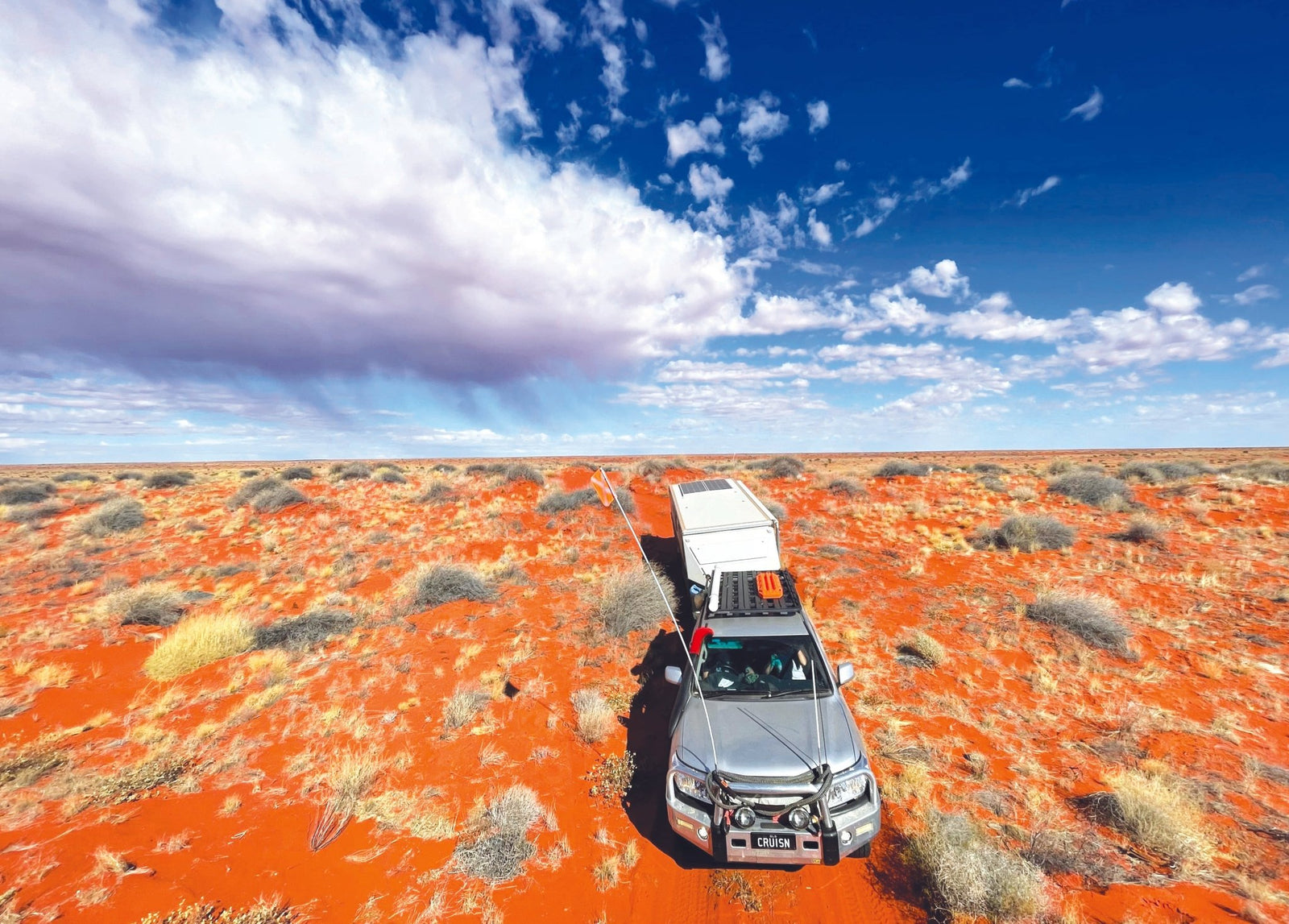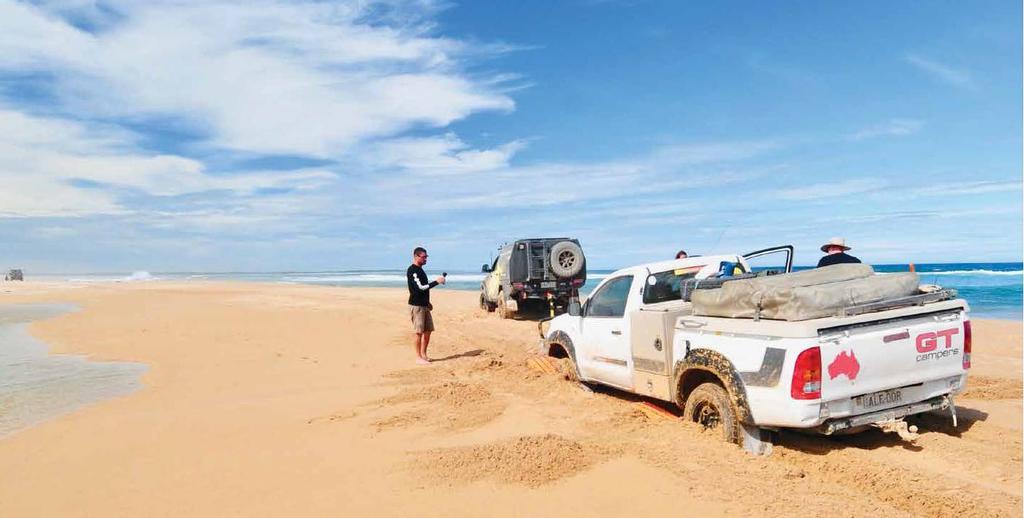Beating the Sand Bog Blues

Tyres play a very important role, especially when travelling off the blacktop. Most OE tyres are softer ‘P’ rated or ‘Passenger style’ constructed tyres, so when replacing those tyres that came with the vehicle straight from the car dealership, go for a Light Truck (LT) constructed tyre as these are stronger and more durable. Also choose an AT type tread pattern, which makes for good all-round traction in vary situations.
My favourite tyres are American-made rubber as I reckon they know more and test more in offroad situations than brands from other countries — BFG, Cooper, or Mickey Thompson make for a great start in the rubber race.
One more thing. A good sand tyre has a relatively large rolling diameter so going tall is better than going wide.
Tyre Pressures
Tyre pressures are the single most important aspect of sand driving, so be prepared to change your tyre pressures regularly, depending on the conditions. Always carry a good tyre pressure gauge (not a stem gauge) and a good air compressor with you.
Lowering tyre pressures makes the going easier and the vehicle’s engine will work less as the tyres roll over the top of the sand instead of pushing through it. Not only that, the ride will be more comfortable and you’ll do less damage to your vehicle and the track.
Remember to watch your tyre pressures. You may start off in the cool of the morning with the pressures at 15psi but in the heat of the afternoon, when the sand is softer as well, tyre pressures could have climbed to well over 20psi making the vehicle struggle and the ride harsher.

Different types of sand (outback vs beach) can call for different things
Always lower the tyre pressures to 140kPa or 20psi as a starting point. My son, who runs Moon Tours (moontours.com.au), specialising in taking camper trailers and hybrid vans into the remote outback, reckons in sand, anything with a ‘2’ in front of it, is too high as far as tyre pressures go.
On the soft beaches of Robe in SA, or the Sandy Cape run in Tasmania, you may find you'll need to go as low as 70-100kPa (10-12psi) to get through. Amongst the dunes of the Simpson where the track conditions rarely vary much over the course of the day (except for the sand getting hotter), 18-20psi is a good starting point. Once again, if the sand is hot and dry, you may have to go lower. On the varying conditions of the Canning Stock Route where one hour you are amongst big dunes and another on rocky gibber-type country (and with a heavily loaded vehicle), 140-170kPa (20-25psi) may be a better compromise. But don’t be afraid to go down in pressure if you find you are having issues in the sand dunes.
With a trailer or camper, even a large one such as an AOR Matrix or Track T4, we’ve found dropping the tyre pressures to 14psi (100kPa) or lower, works pretty well. Trailer tyres are just rolling along and the risk of a puncture is a lot less than the driving wheels of the tow vehicle. With my Trakmaster and my previous Tvans, I run the tyre pressures on the van between 12 and 14psi whenever I’m offroad in the desert or beach, where speed is kept below 60km/h or so.
With low tyre pressures, though, comes a decrease in control and handling. Keep speeds down to a reasonable pace even when you're on a good section of track or beach. Sudden turns may roll the partially deflated tyre off the rim or allow sand to get between the bead and the rim which means you’ll have a slow air leak and eventually a flat tyre. A tyre pressure monitoring system helps here with slow leaks, especially on trailers where a slowly deflating tyre can be hard to pick up. With low tyre pressures, there will also be more body roll, caused by the tyre's sidewalls flexing.
Once back on a good dirt road or blacktop, where you’ll increase your cruising speed to 80km/h or more, you’ll need to pump up your tyres to 25-30psi (170-210kPa) on dirt roads, or normal highway pressures for the blacktop.
Basic Skills of Sand Driving
Keep a close watch on the ever-changing sand scene in front of you as sand can hide many hard-to-see traps which can quickly bring you to a stop.
When the sun is high in the sky, trying to read the sand can be difficult — it’s like being snow blind. Few shadows are cast and in bare sand dune country dips, gullies and walls of sand are almost impossible to see.
Speed and flotation are the keys to success in sand. High ratio 4WD is generally the way to go, unless you're in the real thick stuff or trying to climb dunes (like Big Red out of Birdsville) where low ratio 3rd gear is a good starting point.
Once you become bogged, slip into low ratio, first gear, no matter what, to get you out of the mire. Don’t forget, with modern vehicles, once in sand you may need to switch off the stability control — some vehicles do it automatically when you select low ratio.

This is what you want to avoid
When You're Bogged
If you become bogged, select low ratio and rock the vehicle backwards and forwards. The idea is to build up a small stretch of hard-packed sand that you can use to accelerate off from. Don't spin the wheels.
Here’s where a set or two of MAXTRAX will come in handy. They are the best self-recovery item you can have, and you cannot have too many of them! Six is good if you are towing a camper or van. Clear the sand away from each wheel and build a short ramp with the MAXTRAX for each wheel to run up so the vehicle is not trying to climb out of a steep sided ditch. If that doesn’t work and you haven’t got someone to pull you out, it is either a winch job or a more concentrated effort at digging and making the base firmer and longer with the MAXTRAX. A bullbag or air jack may also help to lift the vehicle and help fill in the bog hole under the wheels.
There’s one piece of recovery gear that is hard to beat, and that is another vehicle! And every vehicle should carry a snatch strap — the latest soft shackle systems from MAXTRAX or ARB are hard to beat and are the safest to use. Still, whatever you have, make sure you know how to use them — they can be deadly!
Another item worth thinking about if you are towing in sand often is the Trailer Skid by MAXTRAX. When bogged, the jockey wheel can be located into the skid, helping no end with the recovery of the van or trailer.
Final Wrap
‘If you haven’t been bogged, you haven’t been four-wheel driving’, or so the saying goes. With a trailer, be it camper trailer, a boat trailer or a bigger van, acting a bit like an anchor on the back of the tow vehicle, getting bogged is easier than ever. Be prepared, because there’ll be times, no matter your skill, experience, or equipment levels, that you will become stuck.
Don’t panic (not that easy on a beach with an incoming tide, I gotta say) and work safely towards getting out of your predicament. The rewards of desert camps and beach sojourns make the effort worthwhile!
Beach Driving
Beaches are best driven when you can drive on the ‘firm pack’ between the high and low tide marks. That makes low tide, or close to low tide, the best time to drive on any beach.
Above the high tide mark, the sand can be very soft, making it pretty tough going. As well, local nesting birdlife and, in places like the west coast of Cape York, nesting turtles, all set their nests above the high tide mark. Some beaches get closed to vehicle traffic then, and for good reason. If forced to drive above the high tide mark at any time, watch out for the nests of our feathered friends and their turtle mates.
Here are some additional tips:
- Stick to any existing wheel tracks — the vehicle in front will have packed the sand down a little, making it easier for those following.
- Avoid sudden changes in direction or acceleration. Coast to a stop and use the brake sparingly.
- If you need to do a 'U' turn, the best way on a beach is to gradually work your way up to the high side of the beach and then turn down the slope. Do the turn in one sweep over the firmer sand.
- Winter storms often create steeply sloping beaches which are difficult to drive on and are generally softer than a flat beach. Beaches are much more gently inclined at the end of summer and are a darn sight easier to drive.
- Quicksand can be found on ocean beaches and in central Australian river beds. These sections of water mixed with sand can be extremely dangerous and it’s not unheard of a vehicle completely vanishing. Some beaches (eg. in the south-east of SA approaching the Vic border and around the ‘Rocks’ on Fraser Island) and seemingly dry riverbeds (eg. the Finke on the way to Boggy Hole) are notoriously bad, so take heed.
- Watch for creeks and streams that exit out across a beach. Eli Creek on Fraser Island, Qld, the streams crossed on the way to Sandy Cape, Tas, and the creeks on the northern end of Cable Beach at Broome, WA, are just some examples. These are often hard to see, sudden and sheer sided, and hit too fast you’ll come to a very quick stop, often with dire consequences.
- Such streams are often too deep to cross above the high tide mark as a small lagoon forms and you are forced to cross where wave action is washing up the beach. The best time for such crossings is as close to dead low tide as possible. The water is shallower and the wave action least. Still, this can be hairy and demands good timing so you run the crossing between waves.
Driving the Dunes
In the Simpson Desert, it’s mandatory that you fly a sand flag. And it’s a bloody good idea whenever you are in sand dune country, whether on the Canning or behind a beach. That helps give any on-coming traffic a warning of your presence.
- Tackle dunes head on and exercise caution on steep slopes — don’t get side on.
- As you approach a dune, get a little run up so that as you hit the base of the dune, you are in the peak torque rev range of the engine. Be in either 3rd or 4th low ratio, or 2nd or 3rd high ratio, depending on how steep and tall the dune is.
- If you don’t get over, don’t try and start off in a lower gear from halfway up the hill — you’ll only burn a clutch out or overheat a torque converter. Back right down and try again, maybe with even a little more momentum than previously — don’t overdo it though!
- On downhill slopes, use the brake sparingly, if at all. Keep the nose of the vehicle pointing downhill. If the vehicle does tend to slew sideways, a little acceleration will keep the wheels rolling and the vehicle pointing in the right direction.
- Watch your speed as you crest a dune and button off if going too quick — it may be a lot steeper on the other side!







